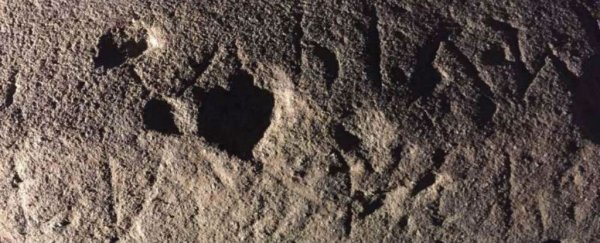Researchers have been translating an inscription on an ancient Etruscan stone slab, and have found mention of the powerful deity, Uni, which suggests the possible existence of an underground cult in the area dedicated to the goddess 2,500 years ago.
Thought to be the Etruscan equivalent of the Greek goddess Hera and the Roman goddess Juno, Uni was likely worshipped as a fertility deity and mother figure by the people of northern Etruria, Italy.
The mention of the goddess Uni is included as part of a sacred text that could be the longest Etruscan inscription of its kind ever discovered on stone, and one of the three longest sacred texts to date, according to lead researcher, Gregory Warden, from the Mugello Valley Archaeological Project and the Southern Methodist University in Texas.
It features around 120 legible letters and punctuation marks, and some words unknown to modern archaeology. "We can at this point affirm that this discovery is one of the most important Etruscan discoveries of the last few decades," says Warden.
The text was inscribed in a stone slab - or stele - measuring 1.2 by 0.6 metres (3.9 by 1.9 feet) and weighing in at a hefty 227 kg (500 pounds).
Dated to the 6th century BC, the stele was found buried in the foundations of what was once a monumental temple at Poggio Colla - an Etruscan archaeological site located near the town of Vicchio in the Mugello region of northern Tuscany.
The site retains several habitation layers of the ancient Etruscans from as early the 7th century BC up until the site was either abandoned or destroyed in the late 3rd century BC.
From the Hellenistic period - marked by the death of Alexander the Great in 323 BC - the Etruscans transitioned from a people that dominated Italy for 500 years to a civilisation absorbed by the Roman Empire.
To give you an idea of just how much there is to discover at Poggio Colla, archaeologists have been excavating the site for almost five decades, and it's still serving up new insights into Etruscan religious and literary practices.
"Cleaning at a restoration centre in Florence has allowed better visibility of the inscribed signs, making it possible to identify a larger sequence of letters and words," one of the team, Adriano Maggiani, told Discovery News. "The presence in the inscription of the name Uni suggests the text has a religious character."
The identification of Uni in the stele text is linked to the discovery of the name Tinia (written here as "Tina"), who was worshipped by the Etruscans as a supreme deity, like their own local version of the ancient Greek's Zeus or Rome's Jupiter.
Uni was believed to be Tinia's wife or consort, and the sanctuary where the stele was discovered appears to have been dedicated to her, based on the wealth of weaving tools and gold jewellery that have previously been uncovered at the site.
 A scence on an Etruscan mirror in which Uni suckles the adult Hercle before he ascends to immortality. Credit: Massimo Pallottino, Indiana University Press
A scence on an Etruscan mirror in which Uni suckles the adult Hercle before he ascends to immortality. Credit: Massimo Pallottino, Indiana University Press
Fragments of a ceramic vase depicting a scene of a goddess giving birth - the earliest known scene of childbirth in western European art - have also been found at the site.
"It is my understanding that the structure of the line that includes both names has bearing on the matter," Warden told Discovery News. "Etruscan sanctuaries are often dedicated to more than one deity. And we have possible indications that the cult may have changed in nature."
The archaeologists have tentatively linked Uni's mention to the existence of an underground cult at the sanctuary, based on the way the stele was placed in the foundations of the temple.
"The centre of worship was an underground fissure that was ritually treated after the destruction of the temple," he said. "Underground cults of this type were often associated with female divinities."
With further translation of the stele text, we'll likely get more of an insight into what was going on at the site more than two millennia ago.
The find has been accepted for publication in an upcoming edition of Etruscan Studies, and will be presented at an exhibit in Florence this week.
